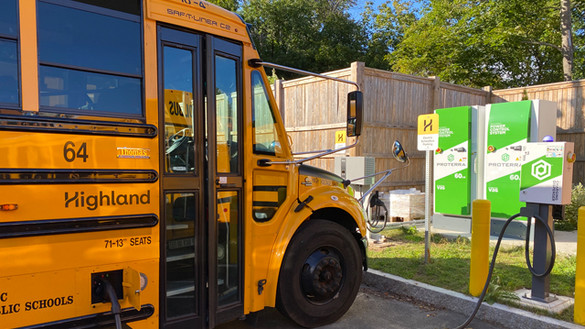
Turning yellow school buses green (with envy)
Yellow school buses are US icons, carrying around 25 million students daily, but they are also big polluters. National Grid Partners' Innovation team spearheaded an initiative with our Clean Transportation colleagues to clean up school journeys, by helping to replace diesel buses with electric alternatives. We asked Mike Cooper, who led the work, to talk about the project, which is also under consideration by regulators in Massachusetts.
Mike remembers riding to school on a traditional yellow bus, like millions of kids around the US. While many of his memories of these journeys are fond, he hasn’t forgotten breathing in the fumes the bus produced as they wafted in through open windows on muggy June days. A few decades on, these experiences influenced his work at National Grid to introduce more electric-powered buses to transport children in a cleaner way.
Chance to clean up a billion journeys a year
On average, around 480,000 school buses carry tens of millions of kids to schools across the US every day – that’s around a billion trips each year. Currently, fewer than 1% of those buses are electric and switching over to more environmentally friendly electric vehicles could drastically reduce harmful carbon dioxide (CO2) emissions.
A 2018 report by US PIRG Education Fund found that switching US school buses from diesel to electric would cut emissions by 5.3 million tons – that’s equivalent to taking about a million cars off the road.
Cutting emissions and costs
Switching to electric buses doesn’t just help to cut carbon emissions, it also lowers running costs for school boards – money that could then be redeployed towards teachers’ salaries or improved school buildings.
The PIRG Education Fund report found that each electric bus would save schools about $2,000 a year in fuel costs and $4,400 in maintenance. This is because electricity is cheaper than other fuels and electric buses are easier to maintain – which is all good news when you think that school buses cover nearly 3.5 billion miles per year.
What’s stopping school buses going electric?
With all these benefits, it seems like a simple choice to switch to electric school buses. But when Mike began to work on this opportunity with National Grid's Clean Transportation team in Product Growth a key stumbling block emerged, purchase cost. While a diesel school bus came in at around $100,000, electric versions were much more expensive, costing up to $350,000 – enough to buy at least three traditional buses.
For school boards that want to switch to electric buses, this cost difference often proves prohibitive. This is a particular problem in lower- and middle-income communities, where pollution levels are likely at their worst too. In fact, higher air pollution in disadvantaged communities has been linked with lower academic performance, so swapping to electric buses could even help some children do better at school. Pollution has also been linked with childhood asthma.
Smoothing the switch
To overcome this challenge, Mike and the Clean Transportation team came up with a programme to help school boards play their part in decarbonisation, starting in upstate New York. They sought nearly $7 million as part of National Grid’s overall Niagara Mohawk rate case to help lower- and middle-income communities buy electric buses and chargers when they replace old vehicles. The idea is that the school pays the cost of a standard diesel bus and the proposed programme offsets the difference to upgrade to an electric vehicle.
To help keep costs low, one option National Grid could explore in the future is to run a tender to manufacturers to purchase 25 buses over three years. By bulk buying the buses, a lower price can be negotiated and all school boards in the programme would be able to benefit. This approach would also help lower supply-chain costs through volume purchase, making future buses cheaper to buy.
Clearing a path to cut emissions and costs
Putting 25 electric buses into service would bring huge benefits, reducing as much pollution as taking 1,600 cars off the road and potentially slashing running costs by a total of $37.5m over the buses’ estimated 12-year life cycle.


